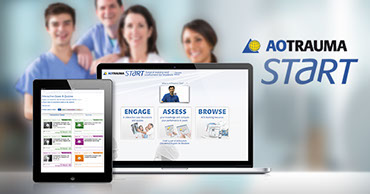_________________________
Check out STaRT now!
Currently available for PC, laptop, and iPad (not yet for smartphones).
Pop-ups must be allowed in your internet browser to view learning modules.
_________________________
 Learn more
Learn more
about STaRT
STaRT—the online learning hub for residents
STaRT (Surgical Training and Assessment for Residents) is a focused online tool that includes interactive case discussions, self-assessment questions, and a targeted overview of AO resources for residents.
The AOTrauma interactive learning hub for orthopedic trauma residents was officially launched on June 27, 2014. STaRT (Surgical Training and Assessment for Residents) has been built with typical patient problems in mind and has three primary features:
- Interactive case discussions
- Self-assessment questions
- Focused overview of AO resources for residents
All learning is classified into three progressive levels of knowledge and is grounded in defined learning objectives. Users can proactively identify their knowledge gaps and then access diverse resources to fill them.
One resident stated that AOTrauma STaRT "makes it easier for residents to find scientific evidence. [AOTrauma STaRT] saves residents time and effort [allowing] us to do our job—saving patients' lives."
Aligned with the AOTrauma Residents Education Program, the goal of the learning hub is to:
- Support self-directed learning
- Enhance effectiveness of basic AO principles and clinical decision-making
- Complement formal educational offerings of certifying bodies and teaching hospitals
STaRT executive editors: Kodi Kojima,
Fred Baumgaertel, and Wa'el Taha
(STaRT is aligned with the AOTrauma Residents Education Program)
Back to top.

_________________________
2014 AOTrauma
Faculty Survey
at a glance
- 740 participants
- 16% response rate
First, positive impression from AOTrauma faculty survey
In May 2014, 740 faculty members answered the call to participate in an AOTrauma faculty survey. Responses are being analyzed, but at first glance they give very good insight into motivation and commitment of AOTrauma faculty.
At the beginning of May 2014, all 4,661 registered faculty members received an email from AOTrauma Education Commission Chairperson Kodi Kojima asking them to participate in the AOTrauma faculty survey. In the following 3 weeks, a total of 740 faculty members completed the extensive questionnaire.
The results reveal insights into the motivation of AOTrauma faculty members. Three quarters of the participants say that their motivation to contribute to AOTrauma has increased since they joined the organization and half of the participants indicate that they would like to increase their commitment with AOTrauma.
To find out how to best motivate faculty members to actually increase their involvement, the survey included questions about the preference of incentives and levels of satisfaction with various aspects of AOTrauma. The findings from those questions and their relation to overall motivation of faculty members are currently being thoroughly analyzed.
Conclusions drawn from the survey analysis will be presented and discussed at the next AOTrauma Education Commission meeting in Barcelona this coming October. Together with education specialists, the management of AOTrauma will then decide on the best strategy to improve its faculty service to better meet the needs of volunteering surgeons.
For those of you who would like to know more about the survey results, look out for the next FacultyFocus issue which will feature an article discussing the implications of the survey for future faculty management.
A big thank you to all who participated in the survey!
Back to top.

_________________________
2014 Asia-Pacific ELP
Where:
Manila, Philippines
When:
May 28–31
(4 days face-to-face)
Faculty:
- Wilson Li
- Mike Baumgaertner
- Chitra Subramaniam
- Miriam Uhlmann
Who attended:
AOTrauma chairpersons from ten countries (China, India, Thailand, Philippines, Japan, Singapore, Bangladesh, Indonesia, Hong Kong, United Arab Emirates)
New educational leaders trained in Asia Pacific
The Educational Leadership Program (ELP; formerly CEP or Chairperson Education Program) held in Manila this May showed that the AO chairpersons in Asia-Pacific are pleased with the direction this course is taking.
The postcourse assessment proved what many of the participants had already stated in their course feedback: the Educational Leadership Program (ELP) in Manila has helped the participating AOTrauma chairpersons to significantly reduce their perceived gaps on topics such as backward planning, leadership, and culture or instructional design. This success is based on a proven program concept that was recently given a new name.
A new name
Since the beginning of this year the former Chairperson Education Program (CEP) is now called the Educational Leadership Program (ELP) in order to avoid confusion with the newly developed Chairperson Training Program (CTP).
Both courses target AO chairpersons. While the CTP is designed for chairpersons with an upcoming assignment at a Basic or Advanced Principles course, the ELP participants need to have a chairperson assignment at a Masters course, a course with a new format, or being in an educational leadership role in their region such as educational officers. Each year AOTrauma offers three ELPs, one in Asia-Pacific, one in North America (including participants from Latin America) and one in Europe (including participants from the Middle East).
An interactive face-to-face event
This years' ELP for the Asia-Pacific region was held at the end of May in Manila, Philippines. It was attended by 16 AO chairpersons from ten different countries (China, India, Thailand, Philippines, Japan, Singapore, Bangladesh, Indonesia, Hong Kong, UAE).The four-day, face-to-face event emphasized the roles and responsibilities of educational leaders and chairpersons in AO.
Faculty members Drs Wilson Li and Mike Baumgaertner and the educationalists Dr Chitra Subramaniam and Miriam Uhlmann also taught the chairpersons about evidence-based best practices in continuing professional development and educational concepts of AO.
Those concepts had already been discussed by the participants in the five weeks of online activities preceding the face-to-face event, so they were all very well-prepared for the interactive live sessions in Manila. Those sessions promoted engaging conversations about the interpretation of AO’s self-assessment, the role of prevention strategies in faculty management, and the use of different educational formats.
Leaving well-prepared chairpersons
As part of the ELP, the participants also observed the Basic Principles of Fracture Management course that took place simultaneously. With the educational principles and best practice in mind, they scrutinized how lectures, small group discussions, and their practical exercises were conducted.
Based on their observations, the participants practiced how to give feedback and acknowledged the Pendelton model of giving feedback as an effective strategy to build a trusting relationship with both the faculty and learners.
During the last half day of the course, the chairpersons were asked to adapt the learnings from the previous sessions to their own courses. In a very productive session they successfully applied curriculum concepts such as the CSI principles (continuity, sequencing, integration) or the backward planning process and departed with a well-developed curriculum for their upcoming courses.
Back to top.
AOTrauma
www.aotrauma.com | education@aotrauma.org
Copyright © 2014 AO Foundation. All rights reserved.




